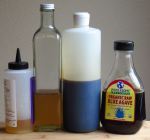 We recently picked up Dave Arnolds new book Liquid Intelligence. If you’re looking for some serious Booze Nerdery, this is the book for you. We’re pretty sure this is the only cocktail book with equations in it. 😉 So it’s right up our alley. One of the many things that caught our eye was the interesting section he had about sweetness. It discusses how different sweeteners are made up of different sugars, and how the these sugars react differently to temperature and can change the perception of sweetness in a drink. So we decided to make a drink using several different sweeteners and see how each sweetener changes the drink profile. Read on to find out what we discovered.
We recently picked up Dave Arnolds new book Liquid Intelligence. If you’re looking for some serious Booze Nerdery, this is the book for you. We’re pretty sure this is the only cocktail book with equations in it. 😉 So it’s right up our alley. One of the many things that caught our eye was the interesting section he had about sweetness. It discusses how different sweeteners are made up of different sugars, and how the these sugars react differently to temperature and can change the perception of sweetness in a drink. So we decided to make a drink using several different sweeteners and see how each sweetener changes the drink profile. Read on to find out what we discovered.
 The four common sweeteners we use are simple syrup, honey, maple syrup and agave syrup. We decided to go with a fairly straightforward cocktail with a minimal number of ingredients so we could easily separate out the affect of the different sweeteners on the drink, and ended up choosing the Lemon Drop. We went with the following proportions:
The four common sweeteners we use are simple syrup, honey, maple syrup and agave syrup. We decided to go with a fairly straightforward cocktail with a minimal number of ingredients so we could easily separate out the affect of the different sweeteners on the drink, and ended up choosing the Lemon Drop. We went with the following proportions:
- 2 oz vodka
- 1 oz lemon juice
- 1/2 oz sweetener
Shake ingredients with ice, strain into a glass. Enjoy. Normally Lemon Drops are served with a sugared rim. However, that’s just a little too sweet for our tastes, plus it would interfere with our results so we omitted it. Add it if you feel the need.
Agave (mostly fructose and some glucose, roughly 2 to 1)
- Nose: Lemon, sweet grain, caramel, vegetal agave.
- Palate: Strong grain notes, lemon, slightly astringent sweetness, hint of dusty mesquite. 1st in terms of sweetness.
Maple Syrup (mostly sucrose with traces of fructose and glucose)
- Nose: Maple and lemon, gentle grain notes.
- Palate: Maple and lemon start through mid-palate. Interesting ozone-y mineral finish. Tied for 3rd place sweetness-wise. The sweetness really kicks in on the finish as opposed to on the front for the simple syrup, which was tied for 3rd.
Simple Syrup (sucrose)
- Nose: Lemon and grain, little bit of malt.
- Palate: Strongly sweet-sour start, followed by grain and lemon. Neutral sweetness. with no added flavors from the sweetener. Has a little bit of creaminess in the mouthfeel that combines with the citrus to be reminiscent of lemon curd. Tied for 3rd place sweetness-wise. The sweetness kicks in at the front, as opposed to on the finish for the maple syrup, which was tied for 3rd.
Honey (roughly 50/50 fructose and glucose)
- Nose: Honey, lemon, sweet grain.
- Palate: Lemon acidity really pops. Honey, lemon, sweet cereal throughout. Bitter lemon peel on the finish. 2nd in terms of sweetness.
According to Mr. Arnold, sweetness also changes based on temperature. We’ve both noticed this behavior but have never made an effort to really quantify it. So we decided to let the drinks warm up for 10-15 minutes and see how the sweetness changed.
- Agave – sweeter, though more bitter notes, like black coffee and unsweetened cocoa.
- Maple syrup – sweeter, but more bitter notes as well as more maple-y.
- Simple syrup – less sweet.
- Honey – about the same.
For all of them them, bitter notes really started coming to the fore as they warmed up. Though whether this was because of temperature or oxidization (or something else entirely) is anyone’s guess.
As you can see, each sweetener clearly affects the final outcome of the cocktail, as well as affecting how the cocktail evolves as it warms up. Which is something one needs to consider, since not everyone sucks down their cocktails as quickly as we do. 🙂 So choose your sweetener thoughtfully.
Thank you Mr. Arnold for creating a book right up our alley. Look for more future posts on some of the many fascinating things that he talks about in his book.
Also, happy Carl Sagan Day, everyone! We love science 🙂
Filed under: agave syrup, honey, lemon juice, maple syrup, vodka
![]()
SOURCE: Booze Nerds – Read entire story here.

